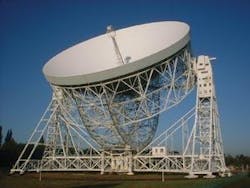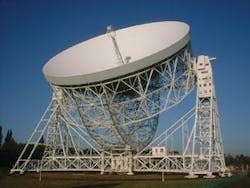Optical network helps glimpse back in time
August 5, 2004 London -- Construction has begun on a fiber-optic network that will help astronomers study galaxy formation billions of light-years ago, observe the death of massive stars in supernova explosions, and search for black holes in distant galaxies. The network in question will link the giant 76-m Lovell telescope at Jodrell Bank Observatory in Cheshire with five other radio telescopes across the UK, which together form the MERLIN array, reports Tami Freeman, deputy editor of FibreSystems Europe in association with LIGHTWAVE Europe.
MERLIN is a high-resolution radio-imaging telescope linking six observatories to create an effective aperture equivalent to the distance between them. The array has a diameter of 217 km, making it the only ground-based facility that can routinely match the resolution of the Hubble Space Telescope.
The new network, called e-MERLIN, will transmit the data that are collected by the five remote telescopes back to Jodrell Bank, where the signals combine with information from the Lovell telescope to form detailed radio images. Previously, these data were transferred over microwave links. However, while the telescope receivers record more than 4 GHz of bandwidth, the microwave links only transmit about 30 MHz. This resulted in most of the received data (more than 99.5%) being wasted.
The optical network, on the other hand, will enable the full 4 GHz of information to be transferred, thereby multiplying the quantity of data used to create each image by more than 100. Project manager Simon Garrington said: "Without a doubt the new optical fiber network is the key to e-MERLIN. The network is the telescope. It performs the same function as the curved dish of the Lovell telescope by bringing radio signals from the five remote telescopes to a common focus at Jodrell Bank."
Along with other improvements--such as new state-of-the-art receivers and the Lovell telescope's recently replaced reflecting surface--the upgrade will boost MERLIN's sensitivity by a factor of 30. "The huge increase in data bandwidth, from 100 Mbits/sec to 30 Gbits/sec per telescope, will give us the power to see galaxies further back in time and space, to learn more about how galaxies and their stars are formed," said Garrington.
Connecting up
Most of e-Merlin's 650-km fiber network will be supplied by Global Crossing, which will also provide colocation facilities to house amplifier equipment. The majority of the fiber is standard G.652 singlemode, with a small section of G.655 (non-zero dispersion-shifted singlemode) fiber. As the telescopes are in rural locations, about 15% of the fiber will be newly installed (by Fujitsu Telecommunications Europe) to link each telescope site to the Global Crossing trunk.
The data leaving each telescope are transported as three 10-Gbit/sec WDM signals, using 200 GHz-spaced channels at around 1550 nm. The bandwidth requirement for e-MERLIN is huge: A constant 30 Gbits/sec from each of the five remote telescopes. Together with traffic from the two local telescopes, the Mark II and the Lovell, the total continuous traffic rate converging on the correlator at Jodrell Bank is 210 Gbits/sec.
"The raw data payload is formatted in a protocol designed specially for radio-astronomy applications," commented Roshene McCool, the Jodrell Bank engineer who is responsible for the optical design. "Standard protocols, such as STM-64, cannot easily be adapted to these broad channels, which require accurate synchronization when they arrive at Jodrell Bank."
She explained that the data mostly consist of broadband white noise, with a weak astronomical signal buried within. Only when data from different telescopes are combined and integrated for several hours does the astronomical signal emerge. Individual bits are therefore not that precious, and the instrument will happily cope with the loss of small amounts of data. "In general, we are aiming for 95% availability rather than the 99.999% target for other telecoms applications," McCool added.
The transmission, amplification, and regeneration equipment is being built at Jodrell Bank in collaboration with US astronomers. Another priority is to develop a
correlator to collate the raw data from the individual telescopes in real time. A typical image may require the accumulation of 20 Pbit of raw data, with a processing
rate of more than 200 Gbits/sec. This correlator is being designed and built at Penticton, British Columbia, by the National Research Council of Canada.
Additional fiber is available for future expansion and increased connectivity. "In principle there is scope to upgrade the network, but there is only so much bandwidth in the sky," said McCool. "Observations in the 4-8 GHz band could use twice our current provision but no more. Higher frequencies could use higher bandwidths, but the UK climate is not well suited to observations above 15 GHz. Also, doubling the transmission bandwidth doubles the processing requirement of the correlator."
MERLIN's director, Philip Diamond, said: "Radio astronomy is crucial to understanding our universe because radio waves penetrate the clouds of cosmic dust and gas that hamper observations with optical telescopes. Our deepest observations with existing instruments have given us glimpses of distant galaxies in the process of formation. We are confident that e-MERLIN will reveal a radio sky teeming with such galaxies, each one of which we can study in detail."
• This article originally appeared in FibreSystems Europe in association with LIGHTWAVE Europe June 2004, p12.

